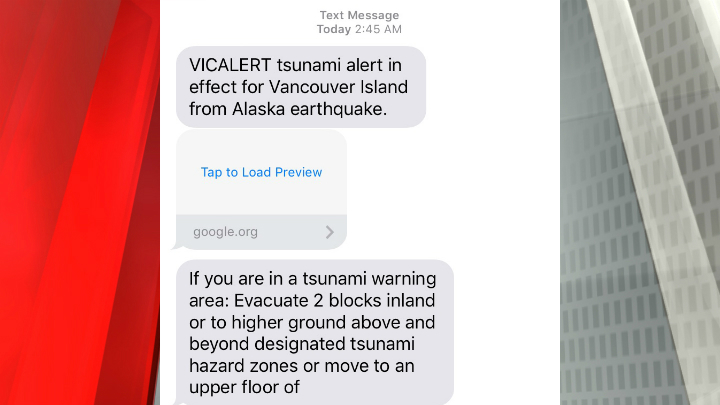

A tsunami alert text from Victoria alert service Tuesday morning.
The City of Victoria is encouraging residents to sign up for their emergency alerts in the wake of Tuesday morning’s tsunami warning on Vancouver Island.
Early Tuesday morning, residents in Victoria and other cities woke up to text alerts warning them to go to higher ground after a 7.9-magnitude quake struck off the coast of Alaska. Environment Canada temporarily issued a tsunami warning that was cancelled around 4:30 a.m.
Sign up for Vic-Alert to receive emergency alerts and updates (such as this morning's tsunami warning) by text, phone and email about major emergencies in Victoria that may impact you. https://t.co/bxh3IQYaco pic.twitter.com/j8G3puWYLo
— City of Victoria (@CityOfVictoria) January 23, 2018
If you live in #VictoriaBC sign up for @CityofVictoria's Vic-Alert, a new emergency notification service. #VicAlert informs you by text, phone and email of major emergencies or disasters that may impact you in #yyj. https://t.co/oD90Nn6fTy pic.twitter.com/ByU5rkogNY
— Ocean Networks ?? (@Ocean_Networks) January 23, 2018
Vic-Alert is a notification service to inform residents and visitors of an emergency situation in specific areas of Victoria and now, the city is reminding people that they can sign up for updated. The service texts people about imminent threats and AMBER alerts. People who sign up can choose which areas of Victoria they would like to see alerts from.
As of Tuesday afternoon, the city said it was experiencing high demand for the sign-up page.
If you are experiencing difficulty accessing the #VicAlert sign-up page, please be patient. We are currently experiencing very high demand. https://t.co/6atZim0UQs
— City of Victoria (@CityOfVictoria) January 23, 2018
Sidney and North Saanich also have emergency messaging systems. The Sidney Fire Department is recommending residents attend a free open house at 7:30 p.m. at the Greenglade Community Centre to learn about emergency preparedness.
This morning's #tsunami advisory is a great example of why we have an emergency notification system for our residents. Sign up now to stay informed during an emergency. https://t.co/O36nNUaFZP
— Town of Sidney (@townofsidneybc) January 23, 2018
Emergency Info BC said in the event of a tsunami alert, some communities may activate their warning systems and other may choose to monitor the situation. It also said AlertReady, a province-wide system that notifies local municipalities of emergencies, will include text alerts by April 2018.
Many on social media posted on Tuesday they were not aware of the tsunami warning until after they woke up, well after the advisory had been cancelled. The City of Victoria said they made a mistake by only sending text and email alerts to mobile phones. while voice calls went to landlines for this morning’s alert. The city says in the future, they will send out alerts via text, email and phone calls to all phones assuming it is warranted.
READ MORE: Residents describe scenes after receiving tsunami warning on Vancouver Island
Natural Resources Canada (NRC) says the first thing you should do when you hear or get a tsunami warning is to head for higher ground and not linger by the shore.
In deep water, the waves are less than a metre high but they can travel at speeds exceeding 800 kilometres per hour. When the waves reach shallow water or narrow inlets they slow down and can build into a wall of water that causes devastation on shore.
READ MORE: Tsunami warning cancelled for Vancouver Island and B.C. coast after large earthquake near Alaska
NRC says the first wave may not be the largest and successive waves may be spaced minutes to hours apart and continue for many hours.
With files from the Canadian Press.




